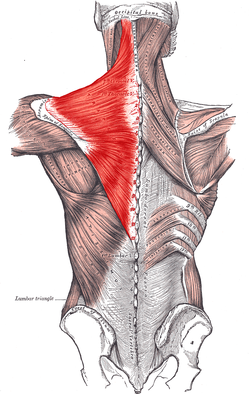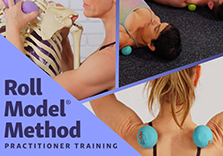
The trapezius sometimes gets a bad reputation for being a superficial muscle that causes shoulder and neck pain. In truth, it is an amazing superhero muscle that takes on a big job with its multiple actions and heavy reputation. The trapezius, sometimes called the “traps,” is a diamond-shaped quadrilateral muscle that blankets the shoulders like a mini superhero cape or a stingray lying on your upper back.

The trapezius has three functional regions: the first is the upper region, which supports the neck in flexing side to side, extending, and rotating left or right on a horizontal plane. The upper fibers also help raise the scapula upwards. Next, the middle region assists in lateral upward rotation of the scapula, elevation and retraction, moving toward the midline of the body. Finally, the lower region extends the thoracic spine, depresses and retracts the scapula, and assists in raising the scapula upward, while rotating the inferior angle of the scapula to the outside (laterally).
The mighty trapezius has several origins beginning on the external occipital protuberance, medial portion of the superior nuchal line of the occiput, ligamentum nuchae and spinous processes of C-7 through T-12. It inserts on the lateral one third of the clavicle, acromion and spine of the scapula. Altogether, the trapezius actions are depression, retraction, elevation, and upward rotation of the scapula, as well as extending and rotating the head and neck.That’s a lot of responsibility!
If you are like most of us, you spend many hours a day in front of a computer screen or using your smartphone in a head forward position or shoulder to ear position that wreaks havoc on your trapezius and shoulders. Even for a superhero, it is exhausting! In addition to the other effects of sitting too much, this repetitive movement can create a hunched over back and shoulders that shrug up to your ears and will lead to tension and pain.
One reasonable question to ask: What is happening to our superhero muscle on a biological level when we are seated in a fixed position for an extended period of time?
After doing all it can to help support the situation, the muscle calls for back up from a group of cells called myofibroblasts who march in and hook their cellular structure into the surrounding connective tissue matrix, exerting a slow contraction into the fibrous webbing. One could say that it is the body’s call for back up scaffolding to help reinforce the shlumpy muscular structure into which we are molding our tissue. It can actually take hours for those contractions to completely let go once they have been engaged.
Eventually, we stand up and move around, maybe heading out for a lunch break or a snack. However, we often fail to entirely release the contractions and end up adding layer upon layer of tension as days and weeks go by in the same position.
You’re now probably wondering how to release the tension in your trapezius. Come back Friday for some fixes!
Get pain relief solutions for your shoulders
Discover how to cure your sore neck
Watch the QuickFix Online videos for shoulders and neck











It truly amazes me how living in a state of sympathetic nervous system becomes the new normal to the point that people don’t even realize that they are constantly shrugging their shoulders and torturing their traps.
I love the description of the body’s back-up scaffolding to reinforce the slumping, shoulders forward posture. When described that way, and how hard/long it takes to release the contractions, I think it will motivate me and my students to take better care of the Stingray Superhero through breaks, better posture, self-care, self-massage and Yoga Tune-up!
Great read to dive into the “Traps” and leave you wanting more. I feel I have spent most of my time looking at the upper fibers; but haven’t given the mid and lower fibers enough attention . We tend to see the upper traps lifting and can address them so quickly. If we want to address stress in the body and the breath this muscle really needs to be looked at entirely.
Strengthening and rolling my trapezius is a must for me. Working at a desk and nursing a shoulder injury, rolling my traps gives me a lot of relief and range of motion. I usually do it with the alpha ball on a wall but I’ve recently starting doing in on the floor and I’m always happy with how my upper back feels!
I loved that you refer to the trapezius as a “superhero” and to our general posture as “shlumpy!” Our Western lifestyle is greatly mis-treating our bodies and how they were meant to function, I look forward to reading the next blog on therapy for this Superhero muscle!!!
Great post on the trapezius. I was unaware about the myofibroblasts but it makes sense now why it is so hard to get the muscle to release. I also appreciated the clear breakdown of the function the muscle preforms. Thank you.
Scaffolding, what a great analogy for the fibres and tension layers that form. Must start to more regularly take the scaffolding in my traps down and clear the job site!
I’m in the middle of Level 1 Training, seated here at the computer for the last 3hr. Remember the homework???My traps are grateful to you, #1 to be recognized as a super hero, cape and all and #2 the reminder to get up and move!
Great reminder to give the traps a bit of love. I always bad mouth them and their elevation tendency in my shoulders. Thank you for the inspiration on taking better care of them
Great article. Left me wanting to know more. How can we release the tension in our traps when so much of our day is spent driving, hunched over a computer, cell phone, iPad, etc. The Yoga Tune Up Balls have definitely helped. Will be looking for more useful tools and technique to relieve the mighty traps.
Up until a few days ago, I didn’t know that the trapezius existed. Now, I’m completely obsessed with it!
I type at a computer all day and I have recently realized that my shoulders are more “comfortable” hunching forward. I’ve noticed that even when I lay down, my shoulders have a slight arch to them. It never occurred to me that the reason why my shoulders felt so good when my yoga teacher pushed them down in savasana is because they were finally in alignment!!
Now that I have the knowledge of the trapezius, how large it really is, and it’s connection with the spinous processes, I know why it is really affected when I’m sitting hunched all day (and not to mention that i sleep in a sideways ball and my shoulders curl in for that too).
I’m working on sitting up straight, rolling the shoulder blades down my back and it’s starting to feel a little more “normal” now. 🙂
Fascinating description of how the trap recruits help to meet our demands of overuse. I’d love to hear about therapeutic exercises for relieving these long lasting contractions before they set in.
I wonder if there will be a shift to a straighter posture if google glasses are successful. If they are there will be no need to forward bend your head because the information is coming at eye level. I wonder if we just raise our screens or lower our seats would we be able to somewhat eliminate that posture? I know for me I am definitely guilty of tensing my trapezius and bringing my shoulders to my ears. This definitely causes lapses in focus because my back is constantly aching. I wish that desks and computers were designed with the human anatomy in mind!
Thank you for this post. It is scary to think about how “office life” and sitting at a computer all day can negatively impact your posture and muscular system. I remember having that achy feeling in my upper back around my trapezoids after typing at a computer for hours. I look forward to reading some your solutions to this problem!
Thank you for such a detailed description of the traps and their duties. How interesting that myofibroblasts come in to assist and then continue to hold the muscle in a contracted position hours after they are no longer needed. I will certainly be sharing this tid-bit with my students in class. Anecdotally, I have noticed that my need to remind students to “relax their shoulders” and “drop them away from their ears” seems to decrease as the class goes on, but I attributed that to learning and focus. Its good to know that there is a physiological component as well. I look forward to learning and teaching a new technique to roll them out.
I am always tight inbetween my shoulder blades and on top of my shoulders. I did not realize that my traps were such a big muscle that needed releif. I typcially sit infront of a computer at a desk and i think my traps take on most of my tensition. I really want to use my balls more to soften and kneed out this area. I definitely need to move and shaken up this area move to bring in more circulation.
Perhaps we need to retrain ourselves to lift our hearts up throughout the day – by remembering to be joyful, our chests will lift and the traps will have a chance to relax…
Thank you, Shakti ~ what a great detailed description of the traps and the important functions that they perform. I am a prisoner at my own desk for hours hunched over, glued to the computer monitor. With my head leading the way, from leaning too far forward, it’s no wonder why my upper back feels like it’s on fire and screaming at me. I am looking forward to your next blog soi can learn how to release this area. This is a good reminder for me to sit in better alignment and be mindful of my posture . I use the YTU balls, now i realize that i need to improve my posture to avoid any further unnecessary pain.
Hello Shakti,
I teach an unwind class on Fridays and neck and shoulder release is one of the most popular requests. I look forward to hearing your strategies for this abused part of our body.
I sit and work at a desk for a lot of my day. Since starting yoga teaching I’ve become more and more aware of the negative impacts that sitting all day has on the body, in particular my trapezius and neck muscles. I do a couple of things to help keep proper posture while at the desk. First I sit on a ball, although it’s still possible to slump over on the ball I feel it keeps me much more aware of what my body is doing because our are actually balancing on the ball. The ball is also not comfortable like a chair is so I feel like I get up and walk around more frequently. I also make sure to take a shoulder break where I’m rolling out my shoulders and neck and doing a few posture check exercises. The last thing I do is I never cross my legs, (yes you can cross your legs while sitting on a ball) I always keep both feet planted on the ground this helps keep my hips, spine and shoulders in alignment.